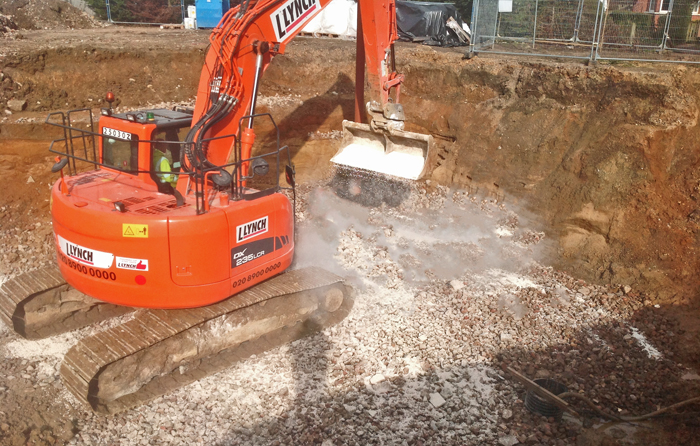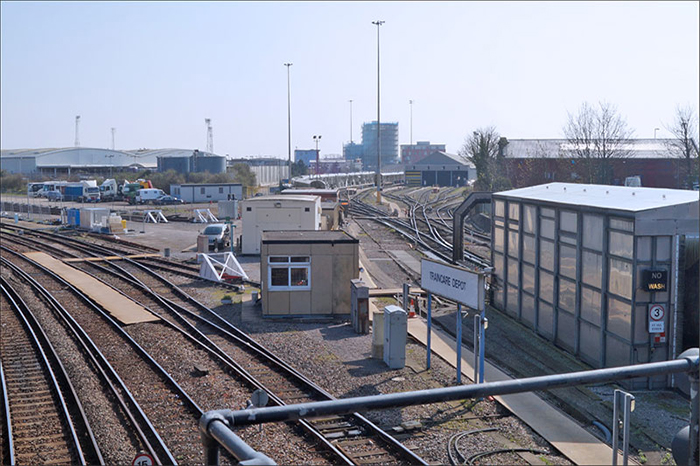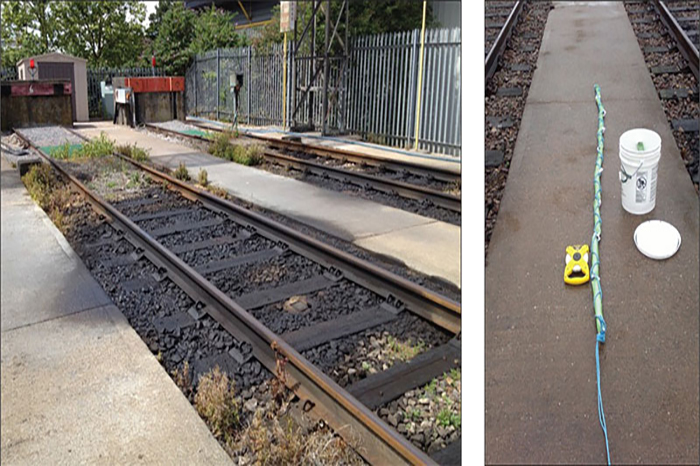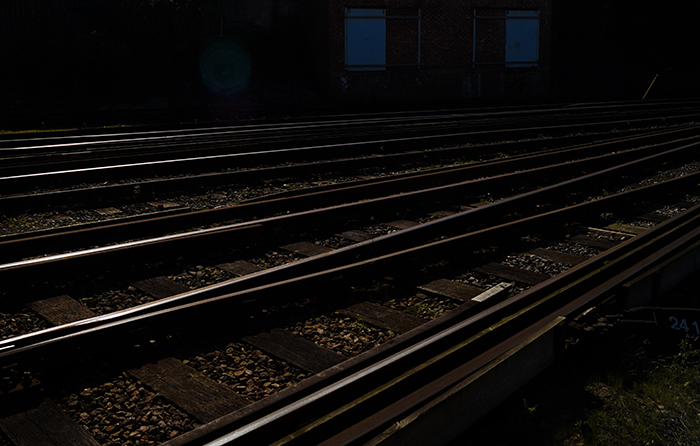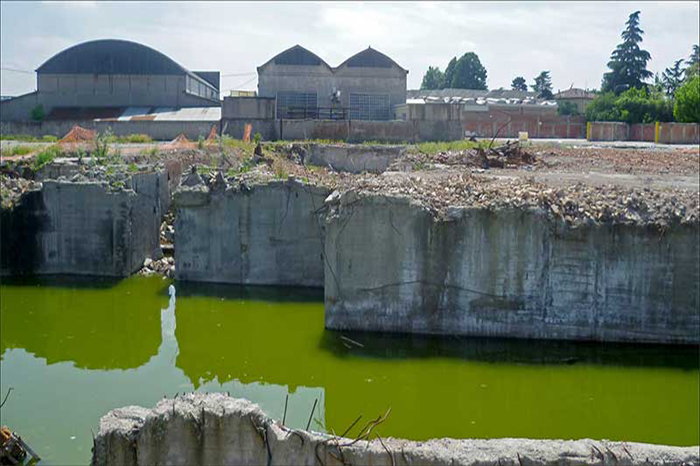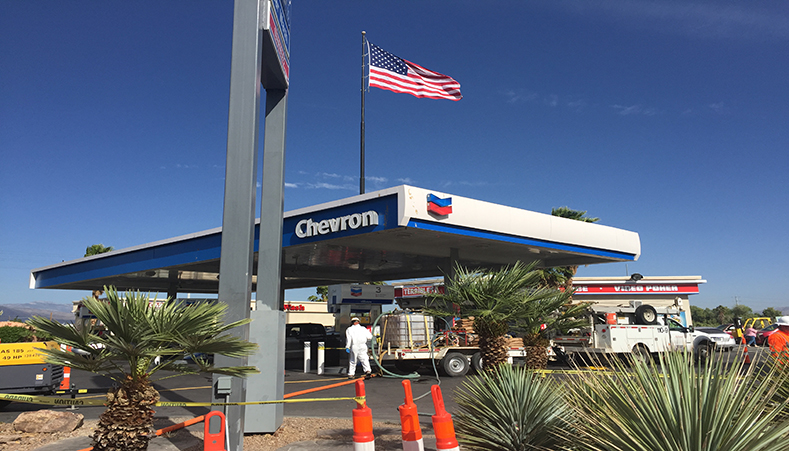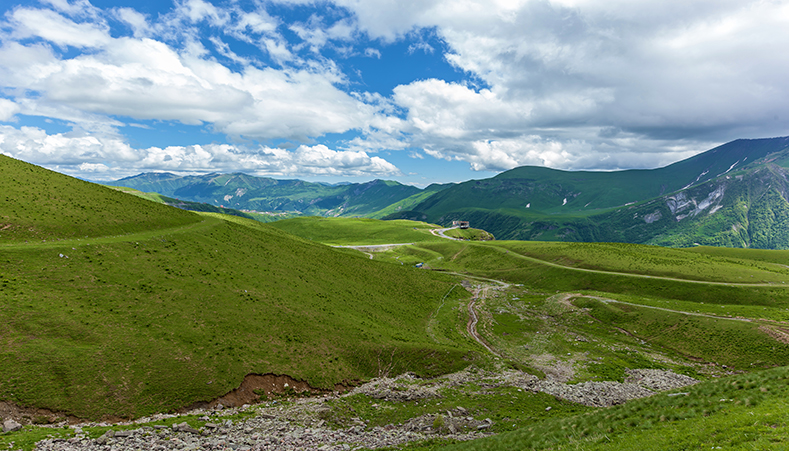Combined Remedy Chosen for FDEP Innovative Technologies Program
Large Dilute BTEX Plume Succesfully Treated To Meet Concentration Milestones
 A former gas station site in Taylor County Florida had undergone prior remedial efforts over the years. The Florida Department of Environmental Protection (FDEP), through its Innovative Technologies Program, engaged the environmental consulting firm, Advanced Environmental Technologies LLC (AET) to design an alternative combined remedial approach employing PlumeStop®, RegenOx® and ORC Advanced®, to sorb, degrade, and destroy the existing petroleum contaminant plume. Prior to full-scale implementation, treatment of this site began with a thorough Design Verification Testing (DVT).
A former gas station site in Taylor County Florida had undergone prior remedial efforts over the years. The Florida Department of Environmental Protection (FDEP), through its Innovative Technologies Program, engaged the environmental consulting firm, Advanced Environmental Technologies LLC (AET) to design an alternative combined remedial approach employing PlumeStop®, RegenOx® and ORC Advanced®, to sorb, degrade, and destroy the existing petroleum contaminant plume. Prior to full-scale implementation, treatment of this site began with a thorough Design Verification Testing (DVT).
This case study features the following:
- An in situ combined remedy approach that was chosen as the most technically-feasible and cost-effective strategy in a competitive bid scenario for the Florida Department of Environmental Protection’s Innovative Technologies Program
- High level of site complexity – flowable fill layer present over the treatment area, difficult geology (i.e., clays and limestone), and close proximity to structures, utilities and a roadway
- Use of PlumeStop, RegenOx, and ORC Advanced to successfully address a large BTEX plume
Integrated remediation at a motorway petrol station in Lombardia, Italy

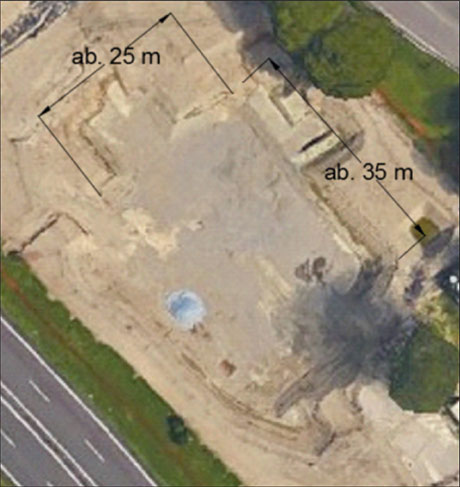
Introduction
A large petrol station located along one of the busiest motorways in northern Italy was undergoing extensive reconstruction, including the demolition of existing buildings, removal of above- and below-ground structures; as well as remediation. The existing underground fuel tanks (USTs) were removed and the contaminated soil surrounding the USTs was excavated to a depth of 5m BGL.
The geology consists of a highly permeable soil comprising sand and gravel to approx. 40m BGL. The average groundwater level is at approximately 4m to 6m BGL, where an extensive contaminant smear zone was observed.
The main excavation was approx. 1,100m2 and 5m deep, with the extent and depth limited by the proximity of the motorway (as well as the presence of groundwater).
The soil at the bottom of the excavation was highly impacted with Total Petroleum Hydrocarbons (TPHs) and BTEX compounds, with concentrations of up to 10,000mg/kg. The groundwater inside the excavation was highly contaminated, with evidence of Light Non Aqueous Phase Liquid (LNAPL) and average concentrations in the range of 500,000μg/L.





Design Approach & Planning
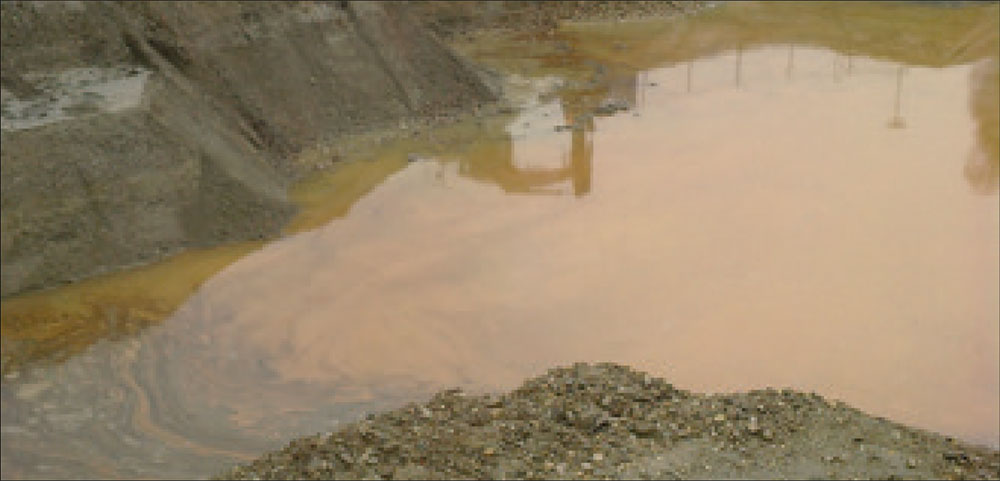 For any treatment approach on this site, to be effective in improving the groundwater quality, it would have to be able to address this secondary source in addition to treating the residual dissolved contamination. The remedial approach also needed to be rapid and effective, in order to allow for immediate back filling. This was because a delay in the construction program would result in a loss of income if the petrol station was not opened on time.
For any treatment approach on this site, to be effective in improving the groundwater quality, it would have to be able to address this secondary source in addition to treating the residual dissolved contamination. The remedial approach also needed to be rapid and effective, in order to allow for immediate back filling. This was because a delay in the construction program would result in a loss of income if the petrol station was not opened on time.
REGENESIS and the Environmental Consultant created an intelligent treatment strategy that took these challenges on board. The remediation approach comprised:
Phase I: Removal of the main contaminant mass present in the saturated soil. This was achieved via Enhanced Chemical Desorption using PetroCleanze, followed by physical abstraction using a vacuum tanker;
Phase II: In Situ biodegradation of the residual dissolved contamination over a period of 9 to 12 months following back fill, via Enhanced Aerobic Biodegradation using ORC Advanced.
 PetroCleanze has been developed by REGENESIS to enhance the desorption of contaminants from soil, so that these can be recovered by physical treatment systems. It provides a cost-effective solution for the in-situ treatment of saturated contamination and smear zones. This allows physical treatment systems to be more effective over a shorter period of time, lowering asymptotes and reducing rebound due to ongoing desorption from the smear zone.
PetroCleanze has been developed by REGENESIS to enhance the desorption of contaminants from soil, so that these can be recovered by physical treatment systems. It provides a cost-effective solution for the in-situ treatment of saturated contamination and smear zones. This allows physical treatment systems to be more effective over a shorter period of time, lowering asymptotes and reducing rebound due to ongoing desorption from the smear zone.
When applied in excavation areas, application is quick and desorbed contaminants can be recovered really easily. Usually two to three application and abstraction rounds are required to remove the bulk of the contamination. PetroCleanze is an inorganic technology and therefore avoids introducing a large oxygen demand (as occurs with using surfactants) and promotes enhanced biological degradation of the residual contamination.
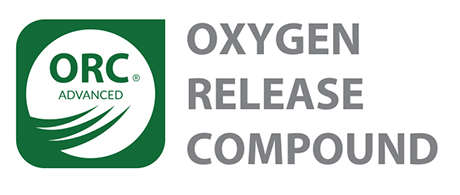 PetroCleanze has been developed by REGENESIS to enhance the desorption of contaminants from soil, so that these can be recovered by physical treatment systems. It provides a cost-effective solution for the in-situ treatment of saturated contamination and smear zones. This allows physical treatment systems to be more effective over a shorter period of time, lowering asymptotes and reducing rebound due to ongoing desorption from the smear zone.
PetroCleanze has been developed by REGENESIS to enhance the desorption of contaminants from soil, so that these can be recovered by physical treatment systems. It provides a cost-effective solution for the in-situ treatment of saturated contamination and smear zones. This allows physical treatment systems to be more effective over a shorter period of time, lowering asymptotes and reducing rebound due to ongoing desorption from the smear zone.
When applied in excavation areas, application is quick and desorbed contaminants can be recovered really easily. Usually two to three application and abstraction rounds are required to remove the bulk of the contamination. PetroCleanze is an inorganic technology and therefore avoids introducing a large oxygen demand (as occurs with using surfactants) and promotes enhanced biological degradation of the residual contamination.
Phase I – Enhanced Desorption and Extraction
- Before application, the excavation was divided in seven segments, leaving some pathways for excavator passage. For each segment, a specific PetroCleanze application dose was defined.
- PetroCleanze was applied in each sub-area through the dig and mixed directly with the remaining impacted soil. Due to the high contaminant mass present in some of the areas, LNAPL appeared on the water in less than one hour after the first application (the photos shown overleaf were taken 30 minutes after application).
- The LNAPL was subsequently removed by selective pumping using a vacuum tanker.
- Repeated soil mixing and desorbed LNAPL removal took place over the following days across the whole area (for a maximum of 3 cycles in the most contaminated areas).
- The repeated soil-mixing allowed for ongoing desorption and removal of the contamination without the need to add more PetroCleanze. This process was continued for all the sub-areas until no more recoverable free phase was present.
- Finally, a short period of de-watering was completed to remove part of the residual dissolved phase contamination, with water samples taken before and after.
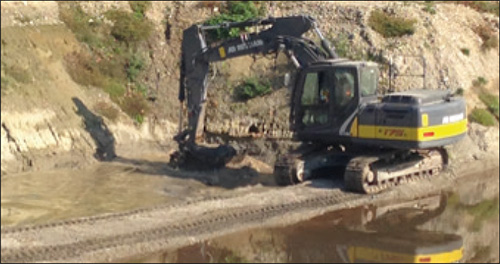
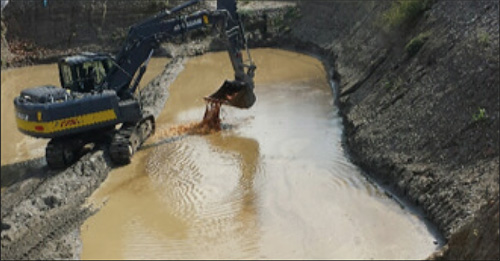
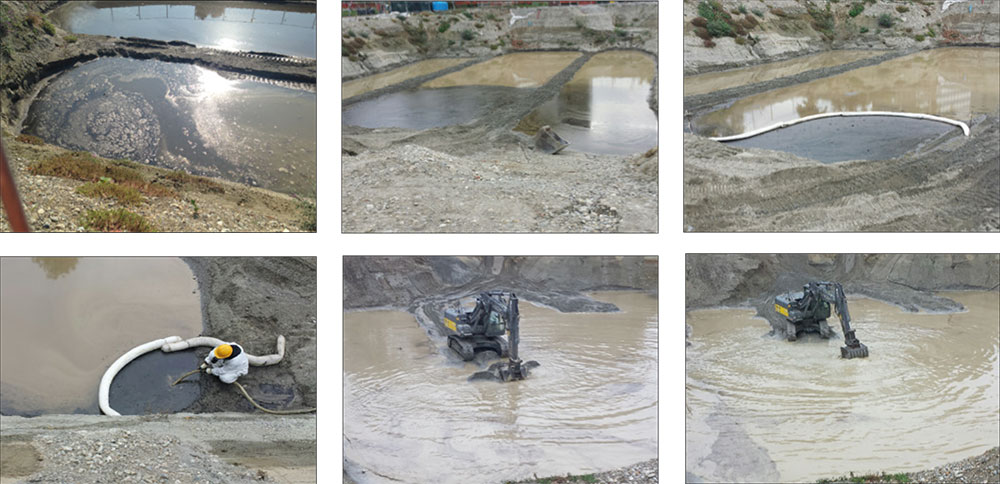
Phase II – Enhanced Aerobic Natural Attenuation
Following the initial excavation and enhanced desorption treatment, an ORC Advanced application was completed. This targeted the residual dissolved phase contamination. The ORC Advanced provided a controlled release of dissolved oxygen in order to stimulate and maintain enhanced aerobic biological degradation of the groundwater contamination for 9-12 months from the single application. This meant that the excavation could be immediately back filled and the construction continued. The remediation of the dissolved phase contamination therefore continued in situ, with no further operational costs and no disruption to the build programme.
To optimise the application process onsite, a pelletised version of ORC Advanced was chosen. This is because they can be applied directly in the excavation without the need for pre-mixing with water. The Pellets also minimise dust formation during application. The pit application was cost-effective, as it did not require additional equipment to be used on site and the application and mixing was safe, quick and straightforward.
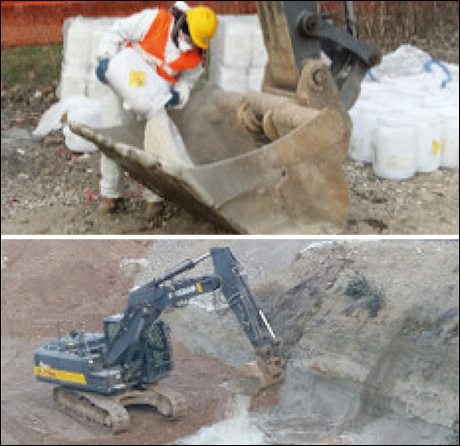
Results
- The remediation activities were completed in approximately 40 days on site, which included the product applications, soil mixing, selective pumping and final pump and treat.
- During this period, more than 400L of petroleum hydrocarbon LNAPL was successfully recovered, as well as approx. 100m3 of highly contaminated groundwater with TPH concentrations in the 100,000-1,000,000μg/L range.
- In addition, 280m3 of contaminated groundwater was removed during the final pump and treat activity (before the ORC Advanced application).
- During desorption and removal, no increase in dissolved phase concentrations was seen in the wells immediately downgradient of the excavation, or on the site boundary. This showed that all desorbed contaminants were successfully extracted during the treatment process.
- Subsequent groundwater monitoring shows a significant decrease in concentrations, avoiding any potential delay to the construction programme. The figure below shows the petroleum hydrocarbon concentrations for each sub-area at baseline (blue), during treatment (orange) and after pump and treat (grey).
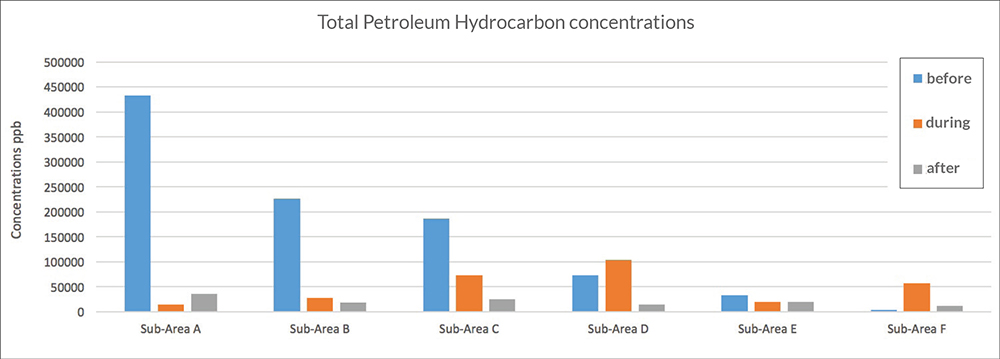
Conclusion
- The site was remediated on time without disruption to the construction program through the use of enhanced desorption and removal, followed by in situ enhanced aerobic biological degradation.
- An integrated remedial approach was created to target each contaminant type/phase, through excavation of impacted soils, enhanced desorption and extraction of LNAPL and high levels of TPH in the groundwater contamination, to biological degradation of the residual dissolved phase contamination.
- Treatment was limited to the target area with the remediation works producing no increase in downgradient contaminant concentrations.
Integrated Remediation of a Petrol Filling Station, Middlesex, UK
Integrated remediation of a former petrol station using enhanced pump and treat, excavation application and barrier injection.Read More
Rapid, Effective Remediation of Free Product at an Active Rail Depot, UK
Augmented Pump and Treat, In Situ Chemical Oxidation (ISCO) and Enhanced Natural Attenuation (ENA) completed under rail lines by REGENESIS Remediation Services. Read More
In Situ Remediation of Petroleum Hydrocarbons at Rail Depot, Bristol, UK
Surface petroleum hydrocarbon contamination had resulted from historic and on-going leaks at a train maintenance depot near Bristol, where trains were stabled overnight. REGENESIS was asked to design a remedial approach for a hotspot treatment of this contamination within one of the rail tracks.ORC Advanced Socks were installed in wells for the treatment of the dissolved phase contaminants in groundwater. The quick application showed the ease of installation, with only validation of the groundwater required to provide evidence of treatment. The ORC Advanced provided a >90% reduction in the groundwater within the hotspot area.
Remediation of a Diesel Plume at an Active Rail Facility in Yorkshire, UK
Enhanced Natural Attenuation of a TPH Plume using ORC Advanced as part of an integrated treatment train solution provided by AECOM.Read More
Treatment of a Diverse Range of Contaminants, Emilia Romagna, Italy
Treatment of a very low permeability geology with mixed contaminants at varying concentrations, using multiple application methods and a range of different REGENESIS products.Read More
ORC Advanced® and PersulfOx® Application Reduces BTEX, TPHg, and TPHd at an Active Service Station in Las Vegas
Significant cost savings to client achieved using enhanced aerobic biodegration and In Situ Chemical Oxidation (ISCO)Read More
State-Funded Cleanup of Former Service Station on Reservation Land
Enhanced Aerobic Biodegradation and In Situ Chemical Oxidation Provides Safe Approach to Remediate TPH-g and BTEX
Project Highlights
- Extensive coordination was required between state-funded Pollution Liability Insurance Agency (PILA) of Washington and US EPA Region 10
- Combined remedy approach using ORC Advanced® and PersulfOx® provided a safe solution for land used to raise livestock
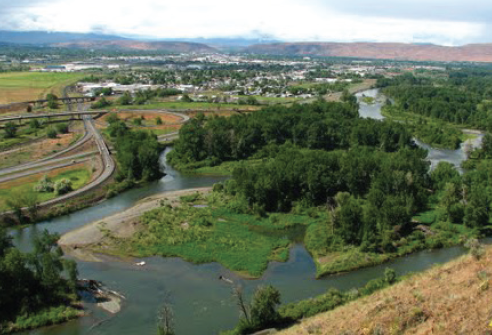
Project Summary
The site located in Wapato, Washington is a former gas station situated on Reservation Land with historical releases dating back >20 years. The site is regulated through US EPA Region 10 and was previously an empty lot used for ranging cattle.
Initial remedial activities included excavation of source-area soil, however persistent contamination remained. Concerns were raised regarding how amendments might affect livestock. As a result, the remediation approach needed to be environmentally benign. The revised remedial plan included Enhanced Aerobic Biodegradation (ORC Advanced) and In Situ Chemical Oxidation (PersulfOx) to reduce the remaining concentrations and meet regulatory goals.
Technology Description
PersulfOx is a chemical oxidant that rapidly reduces the mass of the contaminants. This chemical consists of 90% sodium persulfate and 10% catalyst powder. PersulfOx is very effective in rapid oxidation of petroleum hydrocarbons in both soil and groundwater.
ORC Advanced is an engineered, oxygen release compound designed specifically for enhanced, in situ aerobic bioremediation of petroleum hydrocarbons in groundwater and saturated soils.
Results
An integrated treatment strategy was devised, which included injections in three separate areas. Two areas were treated with PersulfOx and ORC Advanced. The third area was treated with ORC Advanced only.
The by-products of ORC Advanced and PersulfOx are both insoluble and non-toxic, making the application safe and effective. Consequently, there were no issues relating to the landowner’s concern for amendments affecting livestock. A total area of 4,100 ft2 was treated for high levels of BTEX and TPH-g. Monitoring is ongoing.
ISCO and Bioremediation at Former Petrol Station, Pays de la Loire, France
Under a former petrol filling station in the Loire Valley, in France the soil and groundwater was found to be contaminated with petroleum hydrocarbons (primarily BTEX). An integrated in-situ remedial solution has been put in place by a specialist remediation contractor, consisting of 26 PersulfOx injections in the source zone for fast and effective treatment of the most impacted soils and groundwater. ORC Advanced was also applied in the source zone to achieve long term in-situ bioremediation of any remaining petroleum hydrocarbons. In addition, an ORC Advanced barrier has been installed in the downstream plume area, to prevent off-site migration of the contamination.Read More

 Americas
Americas Europe
Europe Français
Français Deutsch
Deutsch Italiano
Italiano Español
Español

